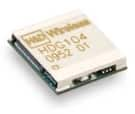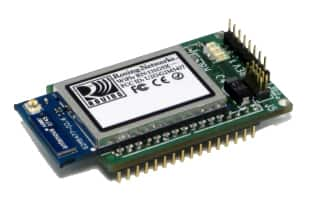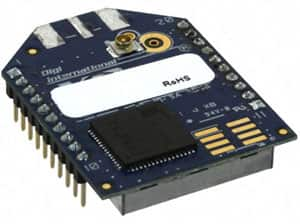Wi-Fi Modules Deliver a Complete Signal Chain Solution
投稿人:电子产品
2011-12-29
IEEE 802.11 standards define communications protocols within the media access control (MAC) and physical (PHY) layers at the lowest levels of the standard TCP/IP protocol stack. While the MAC layer manages communications with other stations, the PHY layer provides wireless radio communications services utilizing a variety of spread-spectrum and signal-carrier modulation techniques to transfer packets reliably despite interference from other radio transmitters in the popular unlicensed bandwidths used for wireless communications.
802.11 standards also define a variety of PHY spread-spectrum techniques, including Frequency Hopping Spread Spectrum (FHSS), Direct Sequence Spread Spectrum (DSSS), and Orthogonal Frequency Division Multiplexing (OFDM). FHSS switches the carrier across different frequencies, while DSSS spreads the signal across a greater frequency spectrum than the original signal bandwidth. OFDM transmits data in parallel across multiple frequency bands at the same time, providing high throughput at a low symbol rate. Within these spread-spectrum schemes, Wi-Fi systems utilize a variety of encoding techniques based on quadrature amplitude modulation (QAM) and phase-shift keying (PSK). These techniques typically require sophisticated modulation and demodulation methods, driving additional complexity into the signal chain.
In designing a basic Wi-Fi system, engineers face a complex signal chain starting with an RF front end capable of filtering and amplifying the RF signal as well as performing the RF-to-intermediate-frequency (IF) conversion needed to generate in-phase (I) and quadrature (Q) signals. Using analog-to-digital converters (ADC), the next stage of the Wi-Fi signal chain relies on a PHY baseband processor to perform carrier sensing and handle frame transmission or reception. Within this stage, quadrature demodulators comprising well-matched mixers, phase shifters, and low-pass filters convert the IF signal to baseband I and Q signal components for further downstream processing. For transmission, quadrature modulators provide this function in reverse. Finally, the MAC controller transfers the data to and from downstream application circuitry and host systems.
Wi-Fi modules eliminate the complexity of Wi-Fi design by providing drop-in hardware functionality as well as pre-built software layers that greatly ease Wi-Fi systems development. Additionally, modules typically minimize the work needed to deploy IEEE 802.11x in systems by generally providing critical type approval and certification from regional authorities. Available modules combine these advantages in a broad range of offerings designed for applications that require either specific combinations of Wi-Fi 802.11x versions or the broadest possible coverage of 802.11 variants.
802.11b/g Wi-Fi
Engineers can find plug-in solutions for mainstream 802.11b/g Wi-Fi networks from a variety of sources and with a broad range of capabilities and operating characteristics. The H&D Wireless HDG104, for example, is a System-in-Package (SiP) device that provides the complete Wi-Fi signal chain, described previously, and is designed to work with external microprocessors or microcontrollers. Designed for low-power embedded applications, the HDG104 requires only 0.2 mW in sleep mode and at only 7.1 × 7.7 mm, offers one of the smallest footprints available for embedded Wi-Fi applications (Figure 1). Along with DMA support for high-throughput data transfer, the module features on-board 160 KB SRAM and 1 KB EEPROM.

For more stand-alone Wi-Fi applications, engineers can select from 802.11b/g modules from Laird Technologies, Quatech, and Roving Networks that combine the signal chain with a complete embedded processor core. Laird's WLM400 combines the signal chain with a 200 MHz ARM9 processor core, SRAM, and Flash memory in a 32.0 x 58.1 x 3.5 mm module. This module offers a complete embedded TCP/IP stack to support Ethernet connectivity as well as USB, UART, and SPI interfaces to host systems.
The Quatech WLNG-XX-DP551 Series also includes an ARM9 core and similarly supports system-level interfaces including Ethernet, SPI, a dual UART, and RS232/422/485 communications. Quatech's module also addresses design needs for different antenna configurations in Wi-Fi applications, offering two U.FL antenna connectors to support both transmit and receive diversity capability in Wi-Fi designs.
The Roving Networks RN-121 combines signal path electronics and a 32-bit RISC microcontroller in a low-power module (Figure 2). This module provides stand alone, embedded Wi-Fi functionality while requiring only 110 mA for transmission, 35 mA during idle mode, and 4 µA during deep sleep.

Figure 2: Roving Networks' RN-121 combines a Wi-Fi signal chain with RISC core to deliver a range of TCP/IP applications (Courtesy of Roving Networks).
Hardware requirements for using the RN-121 are minimal. In the simplest wireless networking configuration, the module requires only four connections -- PWR, TX, RX, and GND. The module needs no external drivers but instead draws on a complete on-board TCP/IP stack to provide built-in networking applications including DHCP, UDP, DNS, ARP, ICMP, TCP, HTTP, and FTP services. Engineers can also utilize the module's additional analog inputs to interface to a variety of sensors such as temperature, audio, motion, and acceleration.
802.11n
802.11n Wi-Fi has emerged as an increasingly popular 802.11 variation because of its high-throughput capabilities, thanks to multiple-input multiple-output (MIMO) communications technology. Despite the increased complexity that this technology represents, engineers can easily deploy 802.11n Wi-Fi networking by dropping in modules that combine 802.11n with different 802.11x versions. For example, the Sagrad SG901-1059, SG901-1071, SG901-1078, and SG901-1091 module families all feature full 802.11b/g/n Wi-Fi capability, with a USB 2.0 interface for host communications. Sagrad offers binary and source for hardware drivers and a complete Wi-Fi stack that supports a comprehensive set of 802.11n features.
The Digi XB24 Wi-Fi RF modules in Digi's XBEE series are 802.11b/g/n drop-in solutions with a flexible selection of antenna options ranging from the XB24-WFPIT-001, which uses an embedded antenna, to the XB24-WFUIT-001, which provides a U.FL connector (Figure 3).

Along with 802.11b/g, the XB24 series offers 802.11n at 6.5, 13, 19.5, 26, 39, 52, 58.5, 65 Mbps data rates. These 2.438 cm x 3.294 cm modules operate from a 3.1-3.6 V supply, requiring 140 mA receive current and up to 260 mA transmit current, while needing less than 2 µA of current in power-down mode. They require no additional external circuitry other than the typical bypass capacitor on Vcc. The modules offer UART and SPI serial connections as well as up to 14 GPIO ports depending on module configuration.
ConnectBlue's OWS451 modules provide full 802.11a/b/g/n Wi-Fi functionality that can be accessed simply as a serial port or UART connected to a host processor. The host processor transmits serial data to the module, which in turn handles all the TCP/IP protocol functions and communications with other network stations via Wi-Fi wireless networking. ConnectBlue's cB-OWS451i-04 module features an internal antenna, while the cB-OWS451x-04 provides U.FL connectors for dual external antenna configurations with transmit and receive diversity.
Beyond these Wi-Fi-only modules, engineers can also increasingly find specialized devices that embed Wi-Fi functionality as part of a bundle of features for key application segments such as personal electronics and entertainment applications. For example, the CSR BC57E687C is a multimedia device that provides Wi-Fi functionality along with Bluetooth and audio-processing functions. Besides a complete Wi-Fi signal chain, the BC57E687C includes a sophisticated DSP coprocessor for audio functionality in wireless headset designs, for example.
Wi-Fi has emerged as the de facto standard for wireless communications for cell phones, computers, and any Internet-connected device. But to add Wi-Fi functionality to a design requires sophisticated signal chains capable of handling RF signals, spread-spectrum communications, complex modulated signal processing, and data communications tasks. Despite this complexity, however, engineers can easily embed Wi-Fi functionality in their designs by selecting from a variety of modules that offer a tremendous range in capability, operating characteristics, and performance.
免责声明:各个作者和/或论坛参与者在本网站发表的观点、看法和意见不代表 DigiKey 的观点、看法和意见,也不代表 DigiKey 官方政策。







 中国
中国